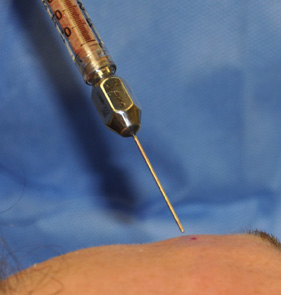As the face ages, deflation through fat absorption occurs for many people. This loss of facial fat causes a sunken appearance and significantly affects the cheek and orbital areas. As a result, restoring some fullness to the cheeks has been part of many facial rejuvenation strategies and a wide variety of materials have been used including implants, resuspension of sagging tissues, and fat injections.

In the May 2011 issue of the Plastic and Reconstructive Surgery journal, the retention of fat injected into the cheeks during facelift surgery was studied. In a single plastic surgeons practice, five patients who had deep-plane facelifts with fat injected into the cheeks were studied. The fat was harvested from the abdomen and prepared by centrifugation. Each patient had about 8 to 9ccs of fat injected into each cheek. Most of the fat was injected over the maxilla to optimize the ogee curve of the youthful face. MRI scans were obtained before surgery of their faces and then up to six months after surgery. Specifically, the thickness of the malar fat pad was measured.
Malar thicknesses were significantly increased at one and six month follow-ups in all patients. The amount of thickness did not change from the first MRI measurement to the last. The T1 and T2 weighted images showed that the increase in malar tissue was due to fat density and not fluid. The average increase in cheek projection was around 0.6 cms for each cheek.
This study shows that fat injected at the time of facelift surgery produces an increase in malar volume that is maintained at 6 months after surgery. This is the first study that documents that viability and value of adding fat at the time of facelift surgery. The fat assists by adding back the soft tissue volume that is lost from the deflation that occurs from facial aging.
Fat grafting as part of facial aesthetic surgery continues to gain momentum although the exact science remains to be precisely defined. There is a lot of reported evidence that fat does survive in the face provided good preparation and injection techniques are used. This reported study is the first that provides quantitative evaluation of fat graft survival.
The real value of this study for me is that it confirms what I have seen clinically with facelift fat injections. I always tell patients that the amount of facial augmentation that one sees around 6 to 8 weeks is what will remain. This study shows that the degree of malar augmentation present at one month after surgery tends to stay. It also demonstrates that adding soft tissue volume from elsewhere is likely better than simply trying to move local tissues around in the effort to gain volume. When you factor in the relative simplicity of fat injections compared to more complex tissue flap and suspension techniques, the use of fat injections as an adjunct to facelift surgery will continue to become more popular.
Dr. Barry Eppley
Indianapolis, Indiana


